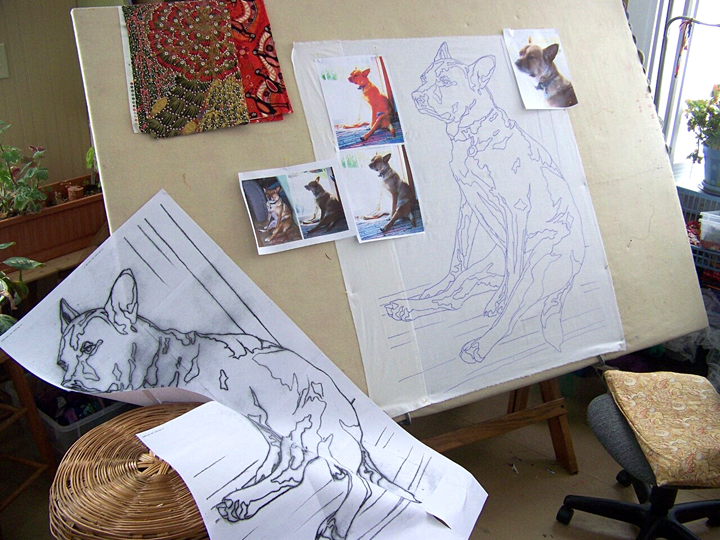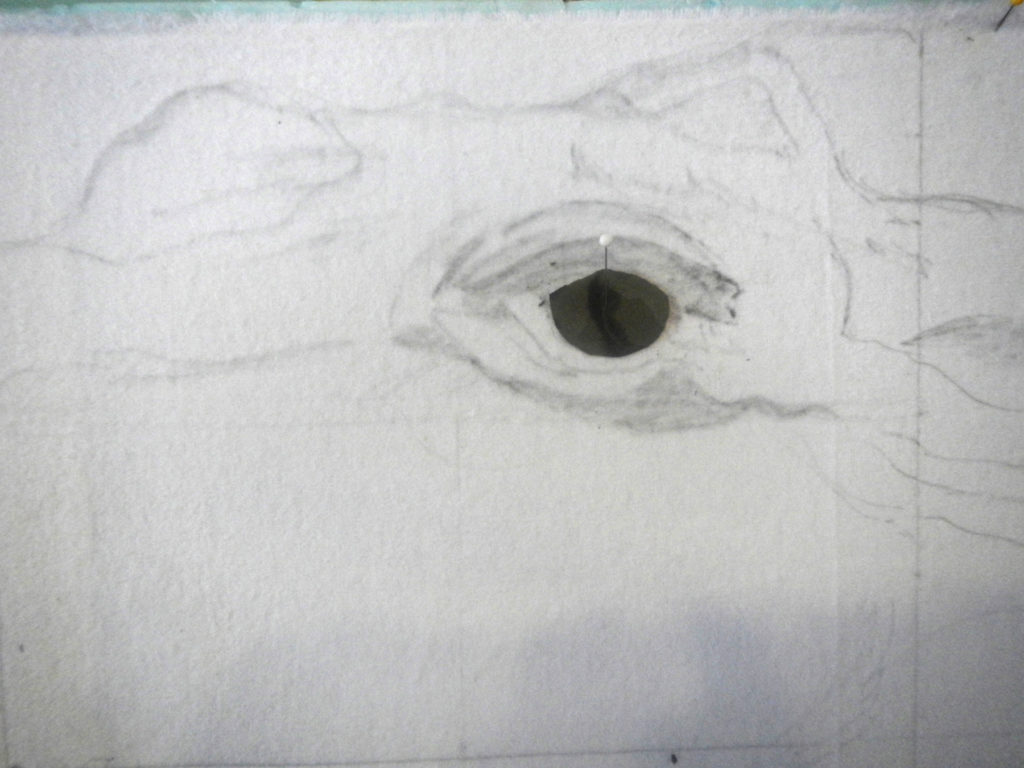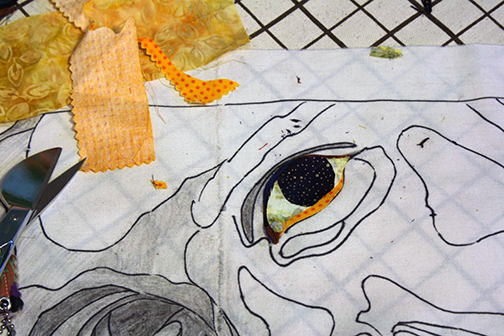Occasionally, when Tom has an idea for a blog post that particularly appeals to him, I hand over the reins for a week. This is one of those occasions. —Susan

“This is also the real secret of the arts: always be a beginner.” —Shunryu Suzuki
It’s fascinating to watch Susan work. Imagine looking over the shoulder of your favorite artist—or pianist or bricklayer—as they do what they do so well. If you didn’t know how much time and effort they’d put into honing their craft, you might be tempted to say that they are performing magic. That’s how easy it looks, that’s how it flows, effortlessly.
But it isn’t easy. And that’s the most impressive part of the illusion, that the effort is invisible.
I think Susan starts a new quilt with the same excitement and trepidation as when she was a beginner. Actually she may have more fear to overcome since she has long lost the beginner’s blissful ignorance. She knows precisely how hard it will be to do what she is considering.
An idea for a quilt has to germinate for some time—often months, sometimes years—before she begins. She refers to this state of expectancy as “dream time,” where her unconscious mind, her sleeping brain, her daydreams—like a computer running a program in the background—plan the making of her next quilt. This long lead time—I think, I imagine—is also a period in which she can conquer her fear, quiet the voices that live in each of us that tell us why we can’t, we shouldn’t, we won’t. It is time in which she replaces those voices with a mind ready and open to receive inspiration.
The poet Rainer Maria Rilke, in his Letters to a Young Poet, says, “If the angel deigns to come, it will be because you have convinced him [or her], not by your tears, but by your humble resolve to be always beginning.”
For Susan each quilt is starting over—not from scratch, of course—but she has to put away the idea that she knows how something will be done and be ready to discover how it will be done. She is always beginning.

“In the beginner’s mind there are many possibilities; in the expert’s mind there are few.” —Shunryu Suzuki
But Susan is also a teacher. She spends much of her professional life instructing people how to create a fabric collaged piece of art. Her students rely on her expertise to guide them toward success (in whatever way they judge that). As beginners it’s easy for them to become overwhelmed by the possibilities they face. They expect her to narrow those possibilities and tell them the “proper” way to do it. I mean, that’s what they pay her for, right?
And there are certain methods and techniques she uses that are, pretty objectively, the right way to do it. There’s a best way to apply glue. There’s a best way to cut your fabric. There’s a best way to blend one fabric into another.
But beyond the mastery of those physical techniques, there’s another layer of artistry that Susan attempts to—not teach—but draw out of her students. Inspiration isn’t something anyone can teach, it has to be allowed to happen. Susan could easily tell each of her students what project to do, which fabrics to use and how to cut them and glue them down—it would probably be easier for her. Easier than allowing them, encouraging them to make these choices for themselves.
As a teacher, Susan needs to be simultaneously both expert and beginner.
An expert where she is teaching a particular technique. But a beginner where she is helping her students find their own unique vision. Sometimes as I watch her teach (especially during her live online classes, in which I play a part), in the course of one coaching session, I can see her switch from one mindset to the other. She will explain in expert detail how to glue down one particularly vexatious piece of fabric, then follow the novice student’s thought process through why they chose that fabric in the first place.
The risk of being an expert is that it can lead to a kind of myopia. An expert knows what has worked before, which may blind them to what else might work.
Rather than passing judgment from her daïs of expertise, she meets the beginner at their level and allows the student to lead her to possibilities only they could have imagined.

“When we have no thought of achievement, no thought of self, we are true beginners. Then we can really learn something.” —Shunryu Suzuki
Susan recently began a new quilt. I have no doubt it will be as spectacular as any of the others that she has turned out over the past two decades, each more impressive than the last. (As her husband I can brag as much as I want!)
Starting with “Samuelsaurus Rex” in 2001, Susan’s work took a more personal turn. After years of churning out quilts to sell, she chose to start making quilts just for herself, the ones she wanted make, rather than the ones she thought would sell. What a leap that was! With a single quilt, the self that identified itself as a certain kind of artist was obliterated.
Even if the subjects she chose weren’t so personal as her adorable three-year-old, her approach to making quilts changed. She took chances she hadn’t felt comfortable making before. She set herself challenges where success was not guaranteed: using pink for her rhino, using only scraps, making a life-size saltwater crocodile. These challenges stimulated her because they broke new ground. Becoming a beginner—repeatedly—has allowed her to learn new things.
Her new quilt (which I am not at liberty to share yet) will be equally groundbreaking because the challenge she has set herself has yet again given her something new to learn.
This way of thinking—and Susan’s example—has made me rethink a personal journey of my own. Objectively, I’ve reached a level of competence at sea kayaking almost as far above a beginner as Susan is from some of her students. And yet it’s only recently I’ve begun to realize how much more I have to learn. That is the gift and curse of competence: the awareness of how much you don’t know.
Can I let go of what I think I know? I have to, if I want to progress. How else will I continue to learn?
Can I abandon the self who so highly values my past accomplishments and become a beginner again?
Can I be both expert and beginner?
Can I always be beginning?

Oh Tom! What an eloquent way to articulate what I’m currently feeling. I AM a true beginner, but am starting a project which demands such reverence only a master should attempt, yet this project burns in my soul. I MUST do it. I NEED to do it. I WILL do it! I’ll pray every time I approach it for wisdom, knowledge and inspiration to give others the respect this particular project demands. I’ll be a beginner! Thank you so much for the inspiration! And thank Susan for me for the snippets of knowledge I’ve gained from her YouTube channel and blog posts.
Bravo Tom, so true and well written.
I look forward to Susan’s next creation.
Tom,
This blog is excellent and inspirational! It is very well written!
Thanks for identifying a challenge that artist face when they initiate a new piece.
Beginning for an artist isn’t about starting the reproduction of a previous work. Doing the same thing again and again is production work not artistry.
The challenges of a fresh beginning are required for a thought to become form of physical reality. Only when a unique thought is realized can it become art.
There, I think, is where the “artist” title is earned. Each and every time a new piece of art is started there is a beginning that includes hope, excitement and also a possible failing. Few people have faith in their capacity to create. Those that trust in their capabilities can and do make the decision to risk the failing. Through effort and work they find ways to hurdle the risk. By trying and being willing to open new doors the first stroke of a paint brush or the writing of a word or the cutting of a piece of fabric can be the first step in becoming ART.
It is in the “beginnings” where artistry is first found.
Tom, thanks for sharing the observations of your wife’s artistry.
In eight days I will begin a collage class with Susan. In that class I will have first hand experience of her artistry. For myself and fellow classmates our personal collage “beginning” will be with her support and guidance. I look forward to that privilege.
Thank you, Tom, for this thoughtful and insightful post. Can’t wait to see what Susan is working on! Taking an in-person workshop with her is on my bucket list!
Tom,
How very much you love your life. Thank you for letting us share an important part of her.
After learning about the basics I realized that perhaps the most important thing I’m learning is how Susan notices the little things like the turn of an ear or the need for a bit of shading or light in a spot unnoticed by me. I think of it as the art of noticing.
Tom thank you for writing this beautiful piece. I needed that nudge today, to always be beginning.
Have a wonderful weekend!
Tom, if you ever get tired of being on the water, you have a wonderful future ahead of you in writing. Truly a wonderful blog post. I love the subject of this piece. I never thought of art in this way before but you are exactly right. As I read through, I kept saying, “Me too!” I have never articulated that feeling of beginning, of feeling unworthy, of feeling excited at the possibilities, of feeling the courage to begin. I have really enjoyed getting to know Susan over the past few years, but I have really enjoyed getting to know you as well. Keep on doing what you do!
Absolutely loved this piece. Thanks, Susan, for turning it over to Tom. Tom, you said it all beautifully. As I participated in the January on-line class, I was totally impressed with your teamwork. I had seen it in blog posts, You Tube videos and in the Master Class Manual, but to be part of it was exciting! I could not get over how Susan could come into a room and give immediate, meaningful feedback on a piece she was just seeing. Tom’s technical ability enhanced this. So very glad I found Susan. Her collage method has taken over my life.
Beautiful!
How true, how true from Sue’s teaching style to finding your beginning and then learning again! Both of you have so much to share and inspire us. Thank you for being who are and giving us permission and inspiration and let us tell our side!
Susan, you have a discerning husband in Tom. The creative process for original art is an uneven process, which has been made more challenging by the strains of a global pandemic on everyone’s emotions, but taking e-classes from you (vastly facilitated by Tom’s technical know-how) has been a bright spot, and I hope some day to meet you in person.
Tom, how exquisite your honoring of Susan and her creative/educational gift and process! I read with an overflowing heart! Thank you for sharing your own unfoldment as well. I think that it is often hard as an artist to continue the quest of “unravelment” and remain new for the sweetness of inspiration to flow. It’s the challenge for all people…
With gratitude.
Very well stated! I read the whole entry. Hope to take an online or in person class to make a grandson’s portrait in the near future.
Thank you for the inspiration! Every new quilt is a unique work of art and you explained the journey in a relaxing comfortable way. Susan is an amazing quilt artist and has shared som many techniques and ideas – I love my first fish collage and her books and blog are very inspiring – especially on a cold windy New England night!
Tom and Susan, thanks for reposing this one. I know I read it back in 2022, but it really hit me this time. So well stated. I am inspired again and again. Figuring out the how to do it in art has always been one of the joys for me in creating art quilts. Another way of saying that is I am always a beginner.